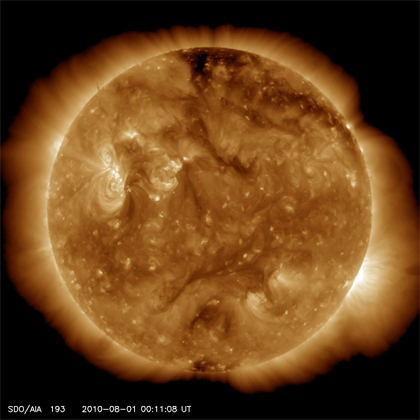The Sun -- Waking Up or Hitting the Snooze?
Well this is typical of how things work out. My last blog post I started back on July 23, Chandra's 11th birthday, and it was about how calm and, well boring, the Sun has been. It took me a couple days to finish it and then a few more for it to get posted. In between me writing the blog about the "quiet sun" and it being posted, there were a bunch of headlines like "Solar Tsunami", "Quiet No More" and then, "Solar Blast Just Misses." So what happened?
Like I wrote earlier, the Sun really isn't my focus, but in fact, nothing has changed. The sunspot number for July was about 23, up from 17 in June, but well the below the 35 expected by even the weakest predictions of the solar cycle. From they perspective of the ham radio people, "Yeah! The Sun finally did something," and the people living way up north finally saw some nice aurora. But we really do expect things like this to be happening more often now that we are two and a half years into the new cycle.
For us, the coronal mass ejection, or CME, that occurred on August 1st was a chance to exercise our procedures on how and when to safe our instruments -- without actually having to do it. We first heard about the CME from an email alert that informed us of a rather seemingly minor X-ray event. Although, it wasn't supposed to be significant, we hadn't had any events in a few years so we were all watching carefully. About 10 am (EDT) of August 3, we received an automated message from our software that the protons were at about 1/3 our trip level.
So, we all checked the plan of the spacecraft for the next 24 hours and noticed that the gratings, which are used to spread-out X-ray light into the different colors of the spectrum, would be in place for the next 10 hours, and then we would move ACIS into the safe position for our usual radiation passage. This was good news since the gratings absorb the soft protons so this would protect ACIS.
The shock associated with the CME arrived at about 1 pm. The rates immediately jumped to about 160% of our threshold. This alone did not cause an alert to trip. That's because we use a two-hour average of the solar particle flux to prevent weak "ripples" from tripping alerts. Sure enough, the rates immediately started to fall... 155%, 150%, 145%, .... 100%, 95%, 90%... At this point, the two-hour period after the shock wave had arrived. It does not take a rocket scientist to see the flaw in the two-hour averages! Although the rate was only 90% of the alert threshold, the average over the two-hours was about 130% and all our pagers went off. (To be honest this isn't actually a flaw in the system, if things are this close to our alert criteria, we probably should check in on things.)
This led to a record short meeting where we all concluded that the spacecraft was safe and getting safer. But to be careful, one of the team scientists volunteered to be on the phone with the Operation Control Center the next time the spacecraft contacted us. This way, we could verify the spacecraft was operating normally and that the proton rates from the Sun were still dropping. They were, so I kept my plans and went to the Red Sox game. After the game I was hoping to see the northern lights (aurora borealis), which would result of the electrons and protons hitting the Earth's magnetic field and raining down on the (magnetic) poles. Alas, it was cloudy in Boston... but the Red Sox won.
Since then, there was a second event. I just saw the Solar Dynamic Observatory movie of the beginning of this month. It appears clear that the two events were related. Although understanding the details will take people who know a lot more than I do. Since then, the Sun has quieted down a bit.
-Scott Wolk
P.S. Last month I wrote, "the most recent forecast (which dates from about May) now predicts a maximum of 90 spots per month in 2013". This should have read a "sunspot number" up to 90. As I tried to make clear in the footnote, counting sunspots is a tricky business.
Please note this is a moderated blog. No pornography, spam, profanity or discriminatory remarks are allowed. No personal attacks are allowed. Users should stay on topic to keep it relevant for the readers.
Read the privacy statement
